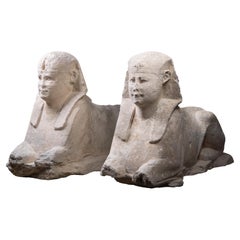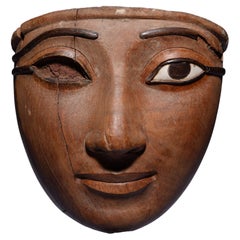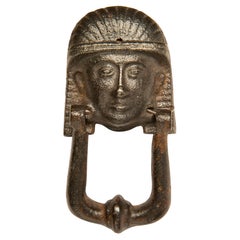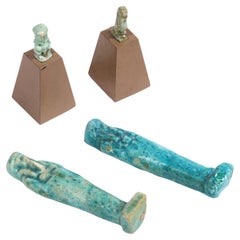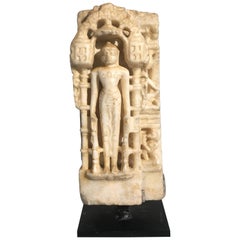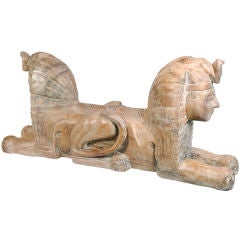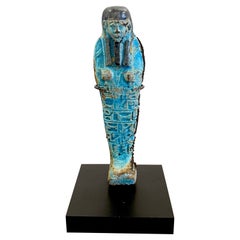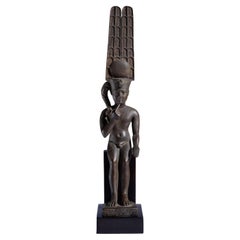Egyptian Figurative Sculptures
1
11
to
1
6
4
11
11
11
1,634
1,609
1,292
509
475
374
270
223
174
165
138
99
74
52
50
50
31
19
4
2
5
3
1
1
Height
to
Width
to
4
3
3
2
2
5
5
5
4
2
Style: Egyptian
Ancient Egyptian Monumental Temple Sphinxes
Located in London, GB
A pair of monumental limestone sphinxes of Pharaoh Nectanebo I, from the processional avenue of the Serapeum of Memphis, 30th Dynasty, circa 379 - 360 BC.
The sphinxes of the Serapeum have captivated travellers since Roman times. However, despite their significance, they are conspicuously absent from the collections of most major museums. Indeed, their existence in private hands is so improbable, and their imitations so numerous, that the present sphinxes were assumed to be modern copies throughout their recent ownership history. Finally recognised and conserved after an extraordinary chance discovery at a garden furniture sale...
Category
15th Century and Earlier Egyptian Antique Egyptian Figurative Sculptures
Materials
Limestone
Exceptional Egyptian Sarcophagus Mask
Located in London, GB
Exceptionally Fine Wooden Sarcophagus Mask
Third Intermediate Period, 21st Dynasty, circa 1069-945 BC.
Acacia wood, rosewood, hippopotamus ivory
Masterfully carved from a single piece of fine-grained hardwood, the present mask is characteristic of the most exquisite funerary art made during the 21st Dynasty, and was probably commissioned for a particularly high-ranking individual.
The oval face displays a gently smiling mouth with full, outlined lips, furrows at the corners and a bow-shaped philtrum. The straight nose with rounded nostrils, the cheeks full and fleshy and the large, almond shaped eyes with heavy lids and tapering cosmetic lines, set below long, sweeping eyebrows.
Social collapse across the Mediterranean in the Late Bronze Age meant that the 21st Dynasty in Egypt was a period of great turmoil. Trade routes were disrupted, governments collapsed, and mass migration occurred. Economic scarcity meant that traditional funerary practices in Egypt were also affected, with a lack of material and financial resources leading to the reuse of preexisting material. As a result, during the 21st Dynasty, 19th and 20th Dynasty coffins changed ownership rapidly and were heavily recycled for new purposes. Tombs were also unmarked allowing them to be shared
by many people. These new practices brought forth a shift in the understanding of funerary paraphernalia. No longer important objects owned forever by the deceased, they were now simply seen as short-term transformative devices, whose symbolic and ritualistic meaning could be appropriated for others. However, paradoxically, the art of coffin-making also reached new heights during this period, and many of the richly dec- orated “yellow” coffins, characteristic of the 21st Dynasty, are remarkable works of art in their own right. Indeed, knowing that coffins were being reused throughout Egypt, the Egyptian élite set themself apart by commissioning lavish sarcophagi decorated with the images and texts meant to help guide them to the afterlife, and which would otherwise have adorned the tomb walls. As coffins were the chief funerary element which now identified the dead and allowed them a physical presence in the world of the living, their quality and appearance were of the utmost importance.
The traditional coffin ensemble was made of three parts: a wooden mummy cover, which laid directly atop the mummy, an inner coffin, and an outer coffin, both made of a lid and case. Additional decorative elements, such as masks, were carved out separately and later glued or pegged to the lids. After the completion of the painted decoration, the sarcophagus was covered in a varnish to give it its yellow colour. Gilding was sometimes used for the coffins of the high priests’ families, notably on parts representing naked skin, such as the face mask. However, some of the élite tactically avoided gilding altogether as to ensure that their coffin would not be looted.
When manufacturing the inner and outer coffins, particular attention was paid to the woodwork. Displaying the skill of the carpenter, this type of funerary art has largely remained unparalleled throughout Egyptian history. The principal wood used to craft the present mask is Acacia nilotica. The evergreen Egyptian acacia was considered sacred and said to be the tree of life, the birthplace of the god Horus, as well as symbolic of Osiris, the god of the dead and resurrection. The modelling of the face in the wood is superb, but the inlays also help mark this mask out as exceptional. Inlaid eyes and eyebrows were extremely rare and reserved to the finest and most expensive coffins. Traditionally, eyes were made of calcite, obsidian, or quartz, and eyebrows of coloured glass paste or bronze. Here, the pupils, eyebrows, and cosmetic lines are inlaid with Dalbergia melanoxylon, a rare type of wood which belongs to the rosewood genus.
In antiquity, however, it was known as Ebony of the Pharaohs, from the Egyptian word “hbny”, meaning dark timber, because of its black, lustrous appearance. An extremely dense and hard wood requiring significant skill to work with, ebony was a luxury material highly coveted by the pharaohs themselves, to make furniture, decorative and funerary objects. The wood was imported with great effort from the southern Land of Punt, most likely modern Sudan, Ethiopia, Djibouti, and Eritrea, alongside other luxury goods such as gold and ivory.
A magnificent ebony throne, recovered in the tomb of King Tutankhamun, illustrates the incredible aesthetic potential of this material and why it was so highly valued by Egyptian royalty. Only élite members of Egyptian society could have afford- ed Ebony of the Pharaoh inlays for their funerary mask.
The sclerae on the present piece were once both inlaid with hippopotamus ivory. Whiter than elephant ivory, this type of ivory is also denser, and more difficult to carve. The use of this luxury material, reputed for its gleaming appearance, enhances the lifelikeness of the eyes. For the Egyptians, hippopotamus ivory was imbued with magic powers. The hippopotamus was indeed both feared and venerated due to its aggressive behaviour. Whilst the male hippopotamus was associated with danger and chaos, the female was benevolent and invoked for protection, especially of the house and
of mothers and their children, through the hippopotamus goddess Tawaret. Thus, not only was hippopotamus ivory used as an inlay and to make practical objects, such as combs and clappers, but it was also used to make talismans like apotropaic wands or knives.
Made during a time of scarcity where few could afford made-to-order coffins, the present mask could have only belonged to one of the highest-ranking individuals in society. Undoubtedly one of the finest Egyptian coffin...
Category
15th Century and Earlier Egyptian Antique Egyptian Figurative Sculptures
Materials
Fruitwood, Hardwood
antique Bronze Door Knocker with Sphinx
Located in Alessandria, Piemonte
O/5517 - Antique bronze door knocker with sphinx - From the early 19th century, after the great Egyptian discoveries with great interest for the whole world.
Beautiful on the door, ...
Category
Early 19th Century French Antique Egyptian Figurative Sculptures
Materials
Bronze
Set of Four Egyptian Antiquities, Pair of Sarcophagus Faience & Two Figurines
Located in New York, NY
This captivating authentic Egyptian Faience set was realized in ancient Egypt circa 3100 BCE. It offers two sarcophagus figurines- suggestive of miniature versions of King Tut's tomb- hand finished in a beautiful turquoise hue (a glaze created by pulverizing the stone into pigment). Additionally, the set features two figurines (one representative of the Egyptian god Anubis), and the other seemingly a depiction of one of the ruler's as a young child also in a turquoise glaze atop volumetric rhombus plinths with tapered sides in a refined terra cotta hue. Full of historical importance (and stunning as stand alone objects) this collection of Egyptian antiquities...
Category
15th Century and Earlier Egyptian Antique Egyptian Figurative Sculptures
Materials
Faience
A modelled pale turquoise glazed Ushabti, Circa 26th Dynasty 664-525BC
Located in ARMADALE, VIC
A finely modelled pale turquoise glazed Ushabti, Circa 26th Dynasty 664-525BC
Provenance: Sotheby’s London Lot 76 14/12/1981 for 725.00 Pounds sterling as part of a group lot.
Category
15th Century and Earlier Egyptian Antique Egyptian Figurative Sculptures
Materials
Stone
Egyptian White Head Plaster Sculpture
Located in Pasadena, CA
Unsigned, this heavy white head plaster sculpture conveys a majestic impression thanks to the skillful combination of curved and sharp lines.
The back of t...
Category
Late 20th Century Unknown Egyptian Figurative Sculptures
Materials
Plaster
Pair of Marble Obelisks
Located in Paris, FR
Brown and Mawe
Pair of obelisks
Marble, Egypt style
Signed Brown & Mawe 149 Strand
Measures: 16 1/5" high, 4 1/2" wide, 4 1/2" depth
Provenance: Private collection
A rare and magnificent pair of English Regency Egyptian...
Category
19th Century Antique Egyptian Figurative Sculptures
Materials
Marble
Grand Tour Statue of Pharaoh Hatshepsut After the Ancient Model
Located in Montreal, QC
Grand Tour statue of Pharaoh Hatshepsut after the ancient model.
Hatshepsut was the fifth pharaoh of the Eighteenth Dynasty of Egypt and was the second historically confirmed female pharaoh, the first being Sobekneferu. The authentic ancient sculpture of Hatshepsut is located in Deir el-Bahri, Thebes, Egypt. Cast painted plaster. Provenance: The Collection of Charles de Beistegui, Château de Groussay. Charles de Beistegui (1894-1970), an enigmatic interior decorator whose passport was Spanish and whose wealth came from his family’s Mexican silver mines. Beistegui to indulge himself in the homes he decorated, such as his Chateau de Groussay...
Category
Early 1900s Egyptian Antique Egyptian Figurative Sculptures
Materials
Plaster
Pair of Italian Polychromed and Painted Egyptian style figural torcheres
Located in Cypress, CA
Impressive opposing pair of Venetian polychromed and paint decorated Egyptian style figural torcheres.
Early 20th century.
A life-size Nubian man and woman, each dressed in traditio...
Category
Early 20th Century Italian Egyptian Figurative Sculptures
Materials
Wood
Large Pair of Empire Style Patinated Bronze Sculptures
Located in London, GB
The pair of figures, one male and one female, are cast in patinated bronze, and are styled as Egyptian figures in the Empire style of Napoleon I. The sculptures are set upon square-f...
Category
20th Century French Egyptian Figurative Sculptures
Materials
Malachite, Ormolu, Bronze
Two Orientalist Gilt and Patinated Bronze Sculptures after Bergman
Located in London, GB
These beautiful sculptures were crafted in Austria in the early 20th century. They are signed, ‘Nam Greb’, after the famous ‘Bergman’ Viennese bronze foundry.
Cast in the Bergman style, the Orientalist sculptures depict two women in Egyptian dress...
Category
Early 20th Century Austrian Egyptian Figurative Sculptures
Materials
Bronze
Related Items
12th Century Indian Carved White Marble Figure of a Jain Tirthankara or Jina
Located in Austin, TX
A well carved Indian white marble Jain temple relief fragment featuring an image of a Jina, circa 12th century, Rajasthan or Gujarat, India.
The Tirthan...
Category
15th Century and Earlier Indian Antique Egyptian Figurative Sculptures
Materials
Marble
Two-Headed Egyptian Sphinx Sculpture
Located in Asheville, NC
This two-headed Egyptian sphinx is constructed of solid wood. The wood has been treated to take on a sandy, almost marble, finish. Unlike the Greek sph...
Category
20th Century Egyptian Egyptian Figurative Sculptures
Materials
Wood
Egyptian Head of a Man
Located in London, GB
Egyptian head of a man, carved granite. 18th Dynasty, circa 1550-1292 B.C.
Carved in beautiful dark granite, this head depicts an elite individual, perha...
Category
15th Century and Earlier Egyptian Antique Egyptian Figurative Sculptures
Materials
Granite
Sculpture of a Plaster Torso
Located in Bagshot, GB
A plaster copy of a muscular male torso.
This a great decorative piece for your home or interior project, or for someone who is looking to start a collection.
Category
21st Century and Contemporary British Egyptian Figurative Sculptures
Materials
Plaster
Vintage Pair of Egyptian Cream Recumbent Sphinxes 20th Century
Located in London, GB
This is a beautiful Vintage pair of French composite sculptures of Egyptian recumbent Sphinx, dating from the late 20th Century.
Each sphinx is modelled wearing a pharaonic headdre...
Category
Late 20th Century Egyptian Figurative Sculptures
Materials
Other
Egyptian scarab with pseudo-hieroglyphic, Anra-type
Located in EL CAMPELLO, ES
ITEM: Scarab with pseudo-hieroglyphic, Anra-type
MATERIAL: Steatite
CULTURE: Egyptian
PERIOD: Second Intermediate Period, 1700 – 1550 B.C
DIMENSIONS: 10 mm x 15 mm
CONDITION: Good co...
Category
15th Century and Earlier Egyptian Antique Egyptian Figurative Sculptures
Materials
Stone
Vintage In Flight Goose Brass Door Knocker 1950s
Located in North Hollywood, CA
Vintage In Flight Goose Brass Door Knocker 1950s.
A timeless piece of mid-twentieth-century vintage in flight goose brass door knocker.
Solid vintage brass flying mallard door knocke...
Category
Mid-20th Century American Egyptian Figurative Sculptures
Materials
Brass
Ancient Egyptian Style Marble Hand-Carved Bust, 20th Century
Located in Southall, GB
Exquisite Hand-Carved Marble Bust: Inspired by the 'Magical Statue' from Thorvaldsen Museum, Copenhagen.
Elevate your space with this extraordinary marble bust, a testament to the m...
Category
Late 20th Century European Egyptian Figurative Sculptures
Materials
Marble
Mini Pair of Vintage Turquoise Glazed Ceramic Foo Dogs, China, circa 1980's
Located in Chatham, ON
Miniature pair of vintage turquoise glazed ceramic Foo Dogs - molded forms - hand painted glossy glaze - unsigned - China - circa 1980's.
Excellent vintage condition - minor glaze...
Category
Late 20th Century Chinese Egyptian Figurative Sculptures
Materials
Ceramic
H 4.63 in W 2 in D 1.25 in
White Large Plaster Hand Sculpture, France, Contemporary
Located in New York, NY
Contemporary French large white plaster hand.
Often used as artist model.
Category
21st Century and Contemporary French Egyptian Figurative Sculptures
Materials
Plaster
Caracalla Plaster Sculpture
Located in Milan, IT
This is the bust of the Roman Emperor Caracalla modeled after a famous sculpture one displayed in the Vatican Museum. In Roman times this bust was a particularly innovative represent...
Category
2010s Italian Egyptian Figurative Sculptures
Materials
Plaster
Large Chinese Tang Dynasty Style Sancai Glazed Pottery Horse, circa 1930
Located in Central England, GB
True in all its elements to the original examples which date from the early Chinese Tang period. The black glazed horse is naturalistically modelled. It stands on a rectangular base ...
Category
Mid-20th Century Chinese Egyptian Figurative Sculptures
Materials
Pottery
Previously Available Items
Egyptian Turquoise Faience Shabti, Museum Mounted
Located in West Palm Beach, FL
Egyptian Turquoise Faience Shabti, Museum Mounted
Egypt, 300-600 BC
Dating back to 300-600 BC, this exceptional Egyptian turquoise faience shabti ...
Category
15th Century and Earlier Egyptian Antique Egyptian Figurative Sculptures
Materials
Pottery
Ancient Egyptian Bronze Statue of Harpocrates
Located in London, GB
Egyptian Bronze Figurine of Harpocrates
Late Period, circa 664-30 B.C.
Bronze with silver inlay
Height: 23.1 cm
Harpocrates - that is, the infant Ho...
Category
15th Century and Earlier Egyptian Antique Egyptian Figurative Sculptures
Materials
Bronze
Ancient Egyptian Tomb Oarsman in Painted Wood
Located in New York, NY
Oarsman carved of wood, originally primed with stucco and painted. This figure formed part of the crew who, some seated, some standing, manned the so-called "sun barges", models of t...
Category
15th Century and Earlier Egyptian Antique Egyptian Figurative Sculptures
Materials
Wood
Elegant Midcentury Sitting Bronze Bastet Sculpture on Marble Base, France, 1960s
Located in Salzburg, AT
Elegant midcentury sitting bronze bastet sculpture, France, 1960s.
The Bastet cat god sits elegantly and straight on a black marble base. The tail lies resting nestled against the...
Category
1960s French Vintage Egyptian Figurative Sculptures
Materials
Marble, Bronze
H 8.08 in W 6.3 in D 2.96 in
Ancient Egyptian Bronze Statue of Ptah
Located in London, GB
An Egyptian Bronze Figure of Ptah
25th or early 26th Dynasty, circa 750-600 B.C.
“For the very great one is Ptah, who gave [life] to all the...
Category
15th Century and Earlier Egyptian Antique Egyptian Figurative Sculptures
Materials
Bronze
Egyptian figurative limestone architectural fragment
Located in Vosselaar, BE
A fragment of a trial piece of a relief with the upper body and head of a male figure with cropped hair facing right. New Kindom 1550-1070 bC. Acquired on the London art market 2022.
Category
15th Century and Earlier Egyptian Antique Egyptian Figurative Sculptures
Materials
Limestone
Egyptian limestone architectural fragment
Located in Vosselaar, BE
A fragment of a rectangulare limestone panel from a larger relief with a portion of a extended arm holding a was sceptre. New Kindom 1550-1070 bC.
Category
15th Century and Earlier Egyptian Antique Egyptian Figurative Sculptures
Materials
Limestone
French Spelter Egyptian Style Table Sculpture, circa 1880
Located in Donhead St Mary, Wiltshire
A French spelter made table sculpture of an Egyptian man sat upon an enthroned Khafre of Gizeh, Egypt, circa 1880.
Category
Late 19th Century French Antique Egyptian Figurative Sculptures
Materials
Spelter
Egyptian Ptolemaic Period Green Faience Shabti Figure
Located in Bishop's Stortford, Hertfordshire
A very fine Egyptian pale green faience shabti figure believed to date from the Ptolemaic Dynasty 305-30BC. The figure is depicted in mummiform and wears...
Category
15th Century and Earlier Egyptian Antique Egyptian Figurative Sculptures
Materials
Ceramic
Early Ptolemaic Egyptian Limestone Relief depicting a Pharaoh
Located in London, GB
Deeply carved sunken relief with the profile of a king, likely Ptolemy II. He wears the Blue Crown, also known as the Khepresh or War Crown. The Sa symbol of protection is visible on...
Category
15th Century and Earlier African Antique Egyptian Figurative Sculptures
Materials
Limestone
Free Shipping
H 16.15 in W 14.97 in D 1.97 in
Set of Two Hand Carved Egyptian Stylized Stone Dieties/Figurines
Located in Miami, FL
Set of two Egyptian stylized god and goddess figures in stone.
These items are lovely gifts for oneself or others.
Will enhance any shelf, table or countertop.
Measurements:
...
Category
20th Century Egyptian Egyptian Figurative Sculptures
Materials
Stone
Set of Framed Egyptian Ushabti Figures
Located in West Palm Beach, FL
This stylish two-piece set of framed Egyptian Ushabti figures were acquired from a Palm Beach estate. And it would seem that the face on each piece ar...
Category
15th Century and Earlier Egyptian Antique Egyptian Figurative Sculptures
Materials
Clay
Egyptian figurative sculptures for sale on 1stDibs.
Find a broad range of unique Egyptian figurative sculptures for sale on 1stDibs. Many of these items were first offered in the Late 20th Century, but contemporary artisans have continued to produce works inspired by this style. If you’re looking to add vintage figurative sculptures created in this style to your space, the works available on 1stDibs include decorative objects, asian art and furniture and other home furnishings, frequently crafted with stone, bronze and other materials. If you’re shopping for used Egyptian figurative sculptures made in a specific country, there are Africa, Egypt, and Europe pieces for sale on 1stDibs. It’s true that these talented designers have at times inspired knockoffs, but our experienced specialists have partnered with only top vetted sellers to offer authentic pieces that come with a buyer protection guarantee. Prices for figurative sculptures differ depending upon multiple factors, including designer, materials, construction methods, condition and provenance. On 1stDibs, the price for these items starts at $580 and tops out at $42,246 while the average work can sell for $4,568.
Recently Viewed
View AllMore Ways To Browse
Bronze Pan Sculpture
American Bronze Sculpture 1900
Floral Marble Sculpture
Sacred Statue
Italian Antique Marble Statue
Lady Head Sculpture
Classical Male Bronze Sculptures
Male Nude Bronzes Signed
Hair Vine
Siren Vintage
Pair Of Angel Wings
Art Nouveau Nymph
Vintage Bow Arrow
Small Stone Figure
Han Dynasty Bronze
Pagoda Figure
Warrior Art Deco
Woman And Cherub
